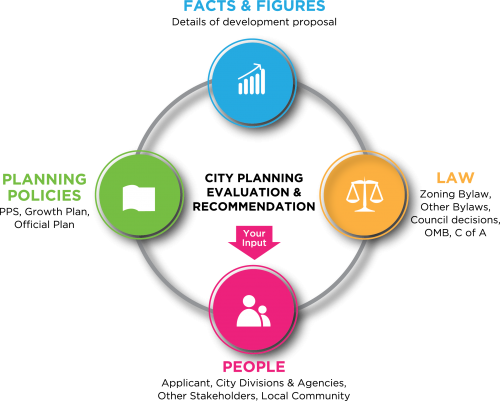
 Consultation with the public and stakeholders is a critical element of the planning process in Ontario, but did you know that planners must also weigh many other inputs when making a recommendation to Council? These include Provincial and Municipal policies like the Planning Act, the Provincial Policy Statement (PPS) and Growth Plan, as well as the Official Plan, zoning and other bylaws, and past Council and OMB decisions. Weighing all of these inputs equally helps us to make responsible recommendations that contribute towards the public good.
Consultation with the public and stakeholders is a critical element of the planning process in Ontario, but did you know that planners must also weigh many other inputs when making a recommendation to Council? These include Provincial and Municipal policies like the Planning Act, the Provincial Policy Statement (PPS) and Growth Plan, as well as the Official Plan, zoning and other bylaws, and past Council and OMB decisions. Weighing all of these inputs equally helps us to make responsible recommendations that contribute towards the public good.
Below, you will learn all about when we undertake public engagement and why, including when it is required by law and how feedback is used. You’ll also find a series of links to some of the more innovative engagement projects that are helping us become the most engaged city in North America.
When City planning staff engage with the community, we always try to ensure that outcomes reflect the vision and values of Toronto’s residents and communities.
We do this by following these three objectives:
A major objective of any engagement process is to build capacity and generate the kind of mutual learning that is needed in order for constructive dialogue to occur. This means ensuring that residents and stakeholders are equipped with the right information that will allow them to engage meaningfully in a process.
Tools we use to build capacity and inform participation:
Another major objective of a lot of our public engagement is to inform planning processes. This includes, most typically, the development review process, but also occurs through processes related to planning studies and Official Plan reviews.
Tools we use to inform planning processes:
A key objective of the City’s new Strategic Actions, 2013-2018 is city building, including the implementation of smart urban growth strategies that ensure growth positively contributes to Toronto as a place to live, work and play. Ensuring that this occurs requires positive dialogue with residents and stakeholders around issues of city-wide importance and that impact quality of life. Currently, there is no formalized regular process dedicated to city building, although, recently, initiatives such as PiPs and the Chief Planner Roundtables have been convened with the objective of enabling more effective discussions around city building.
The city becomes stronger when we plan it together. Each year, City Planning engages tens of thousands of people through public meetings alone, and many thousands more online.
Currently, we engage our residents and stakeholders when:
When a property owner wants to redevelop a piece of land, they must typically submit a development application to the City. The review of development applications is a big part of what City Planning does. In fact, in 2013, City Planning processed over 3,800 development applications. The process involves a public meeting before a planning report is prepared by staff. The public is always welcome to make comments at the Community Council meeting where the report is tabled.
In high growth areas, or in areas that require special attention (like the waterfront, or Heritage Conservation Districts), area-based plans are created. These might be Secondary Plans, Avenue Studies, or Urban Design studies. For example, in 2013, we initiated three Heritage Conservation District studies, as well as Eglinton Connects, which is a detailed planning analysis of the entire route of the Eglinton LRT.
Some planning processes are of city-wide importance, like the 5-year review of our Official Plan policies that is currently underway, the Tall Buildings Guidelines, Feeling Congested?, or Growing Conversations.
Sometimes we need our conversations with you to be about big ideas that set city-wide priorities, like the Chief Planner Roundtable. Sometimes, we just want to give you an opportunity to check-in with us and ask some questions, like with PiPs.
In City Planning, we’re always testing innovative new ways of engaging you in the work we do. Here are some of our most exciting recent projects: